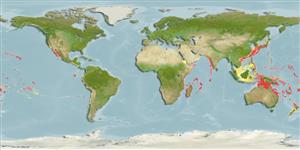Environment: milieu / climate zone / depth range / distribution range
Ökologie
seewasser riff-verbunden. Tropical
Western Pacific: Japan to Australia and the Kermadec Islands. Recently reported from Tonga (Ref. 53797).
Size / Gewicht / Alter
Maturity: Lm ? range ? - ? cm
Max length : 5.0 cm TL Männchen/unbestimmt; (Ref. 2334)
Rückenflossenweichstrahlen (insgesamt): 12-43; Afterflossenweichstrahlen: 22 - 40. Body fully scale. At least some of the dorsal saddles reaching a distinct lateral band. Combined number of soft rays in dorsal and anal fins usually 49 to 55 (Ref 12874).
A cryptic species that occurs on sandy or gravel bottoms. Pointed snout is used for burrowing; eyes directed upwards for sighting prey. Found from shallow tide pools to at least 150 m (Ref. 2334). Eyes move independently and possess a refractive cornea, a convexiclivate fovea and a non-spherical lens (Ref. 50869). Neither cleitheral spine gland nor anterolateral glandural goove with gland is present (Ref. 57406).
Life cycle and mating behavior
Geschlechtsreife | Fortpflanzung | Ablaichen | Eier | Fecundity | Larven
Randall, J.E., G.R. Allen and R.C. Steene, 1990. Fishes of the Great Barrier Reef and Coral Sea. University of Hawaii Press, Honolulu, Hawaii. 506 p. (Ref. 2334)
IUCN Rote Liste Status (Ref. 130435)
Bedrohung für Menschen
Harmless
Nutzung durch Menschen
Mehr Information
NamenSynonymeMetabolismusRäuberÖkotoxikologieFortpflanzungGeschlechtsreifeAblaichenSpawning aggregationFecundityEierEientwicklung
ReferenzenAquakulturAquakultur ProfilZuchtlinienGenetikElectrophoresesVererbbarkeitKrankheitenVerarbeitungNutrientsMass conversion
PartnerBilderStamps, Coins Misc.LauteCiguateraGeschwindigkeitSchwimmstilKiemenoberflächeOtolithsGehirngrößeSehfähigkeit
Tools
Zusatzinformationen
Download XML
Internet Quellen
Estimates based on models
Preferred temperature (Ref.
123201): 18.2 - 28.8, mean 27 °C (based on 664 cells).
Phylogenetic diversity index (Ref.
82804): PD
50 = 0.5156 [Uniqueness, from 0.5 = low to 2.0 = high].
Bayesian length-weight: a=0.00389 (0.00180 - 0.00842), b=3.12 (2.94 - 3.30), in cm total length, based on all LWR estimates for this body shape (Ref.
93245).
Trophic level (Ref.
69278): 3.0 ±0.00 se; based on food items.
Fishing Vulnerability (Ref.
59153): Low vulnerability (10 of 100).
Nutrients (Ref.
124155): Calcium = 196 [92, 406] mg/100g; Iron = 0.953 [0.517, 1.781] mg/100g; Protein = 17.8 [16.5, 19.0] %; Omega3 = 0.0915 [, ] g/100g; Selenium = 16.7 [6.6, 42.5] μg/100g; VitaminA = 380 [100, 1,505] μg/100g; Zinc = 2.72 [1.66, 4.19] mg/100g (wet weight);
